Study on the Extraction of CT Images with Non-Uniform Illumination for the Microstructure of Asphalt Mixture
Abstract
:1. Introduction
2. Materials and Methods
2.1. Materials
2.2. Gradation Design
2.3. Optimum Asphalt Content and Test Pieces Preparation
2.4. Scan by Industrial CT
3. CT Image Feature Analysis
4. Image-Processing Method for Asphalt Mixture
4.1. Adaptive CT Image-Processing Method
4.1.1. Obtain the Center and Radius of the Test Piece
4.1.2. Image Brightness Homogenization
4.1.3. Image Filtering and Noise Reduction
4.1.4. Global Otsu Threshold Segmentation
4.1.5. Image Morphological Processing
4.2. Ring Division Method
5. Grading Verification of 3D Reconstruction Model
6. Conclusions
- (1)
- The adaptive CT image-processing method was based on the recognition of the center and radius of the test piece in the image. After the voids were removed from the image, the gray distribution was counted along the radial direction of the test piece, the grayscale distribution along the radial direction of the test piece was adjusted to homogenize the brightness, and the one-dimensional entropy value of the image was applied to characterize the effect of brightness homogenization. As indicated by the results, the entropy value reduced significantly after the image was brightened. The problem of artifacts in CT images of asphalt mixture has been effectively resolved.
- (2)
- The larger the window of the Wiener filter, the more significant was the noise reduction effect on the CT image. Simultaneously, however, it caused image sharpness to be reduced. The 7 × 7 Wiener filter was able to produce a better effect of noise reduction without compromising image sharpness.
- (3)
- In order to avoid subjectivity caused by the visual observation of the image processing effect, the binary images obtained by the three methods were imported into the 3D reconstruction software to extract the particle information contained in the reconstruction model and to perform virtual sieving. The model’s gradation curve of aggregates of 4.75 mm and above was obtained, and the errors between the model gradation curves and the real gradation curves were characterized by statistical parameters. It was discovered that compared with other methods, model gradation caused the least significant error from the real gradation, the degree of aggregate adhesion was also lower, and the adaptive image-processing method showed a strong adaptability to the processing of CT images for different kinds of mixtures.
Author Contributions
Funding
Institutional Review Board Statement
Informed Consent Statement
Data Availability Statement
Conflicts of Interest
References
- Masad, E.; Muhunthan, B.; Shashidhar, N.; Harman, T. Internal Structure Characterization of Asphalt Concrete Using Image Analysis. J. Comput. Civ. Eng. 1999, 13, 88–95. [Google Scholar] [CrossRef]
- De Chiffre, L.; Carmignato, S.; Kruth, J.-P.; Schmitt, R.; Weckenmann, A. Industrial applications of computed tomography. Cirp Ann. Manuf. Technol. 2014, 63, 655–677. [Google Scholar] [CrossRef]
- Gao, H.; Zhang, L.; Chen, Z.; Xing, Y.; Li, S. Beam Hardening Correction for Middle-Energy Industrial Computerized Tomography. IEEE Trans. Nucl. Sci. 2006, 53, 2796–2807. [Google Scholar] [CrossRef]
- Hanna, R.D.; Ketcham, R. X-ray Computed Tomography of Planetary Materials: A Primer and Review of Recent Studies. Geochemistry 2017, 77, 547–572. [Google Scholar] [CrossRef]
- Lifton, J.; Mcbride, J. The Application of Beam Hardening Correction for Industrial X-Ray Computed Tomography. In Proceedings of the 5th International Symposium on NDT in Aerospace, Singapore, 13–15 November 2013. [Google Scholar]
- Jennings, R.J. A Method for Comparing Beam-Hardening Filter Materials for Diagnostic Radiology. Med. Phys. 1988, 15, 588–599. [Google Scholar] [CrossRef] [PubMed]
- Wang, M. Industrial Tomography: Systems and Applications; Elsevier: Amsterdam, The Netherlands, 2015. [Google Scholar]
- Chen, S.; Xi, X.; Li, L.; Luo, L.; Han, Y.; Wang, J.; Yan, B. A Filter Design Method for Beam Hardening Correction in Middle-Energy X-Ray Computed Tomography. In Proceedings of the 8th International Conference on Digital Image Processing (ICDIP 2016), Chengu, China, 20–22 May 2016. [Google Scholar] [CrossRef]
- Hammersberg, P.; Mångård, M. Correction for Beam Hardening Artefacts in Computerised Tomography. J. X-ray Sci. Technol. 1998, 8, 75–93. [Google Scholar]
- Yan, C.H.; Whalen, R.; Beaupre, G.; Yen, S.; Napel, S. Reconstruction Algorithm for Polychromatic CT Imaging: Application to Beam Hardening Correction. IEEE Trans. Med. Imaging 2002, 19, 1–11. [Google Scholar] [CrossRef]
- Yang, F.; Zhang, D.; Zhang, H.; Huang, K. Cupping Artifacts Correction for Polychromatic X-Ray Cone-Beam Computed Tomography Based on Projection Compensation and Hardening Behavior. Biomed. Signal Process. Control. 2020, 57, 101823. [Google Scholar] [CrossRef]
- Hasheminejad, N.; Pipintakos, G.; Vuye, C.; De Kerf, T.; Ghalandari, T.; Blom, J.; Bergh, W.V.D. Utilizing deep learning and advanced image processing techniques to investigate the microstructure of a waxy bitumen. Constr. Build. Mater. 2020, 313, 125481. [Google Scholar] [CrossRef]
- Margaritis, A.; Pipintakos, G.; Varveri, A.; Jacobs, G.; Hasheminejad, N.; Blom, J.; Bergh, W.V.D. Towards an enhanced fatigue evaluation of bituminous mortars. Constr. Build. Mater. 2021, 275, 121578. [Google Scholar] [CrossRef]
- Chen, L.; Wang, Y.H. Improved Image Unevenness Reduction and Thresholding Methods for Effective Asphalt X-Ray CT Image Segmentation. J. Comput. Civ. Eng. 2017, 31, 04017002. [Google Scholar] [CrossRef]
- Zhang, S.W.; Zhang, X.N.; Wu, Z.Y.; Shi, L.W. Research on Asphalt Mixture Injury Digital Image Based on Enhancement and Segmentation Processing Technology. Appl. Mech. Mater. 2013, 470, 832–837. [Google Scholar] [CrossRef]
- Adhikari, S.; You, Z. Investigating the Sensitivity of Aggregate Size within Sand Mastic by Modeling The microstructure of an Asphalt Mixture. J. Mater. Civ. Eng. 2011, 5, 580–586. [Google Scholar] [CrossRef]
- Hassan, N.A.; Airey, G.D.; Khan, R.; Collop, A.C. Nondestructive Characterisation of The Effect of Asphalt Mixture Compaction on Aggregate Orientation and Segregation Using X-ray Computed Tomography. Int. J. Pavement Res. Technol. 2012, 5, 84–92. [Google Scholar] [CrossRef]
- Shi, L.; Wang, D.; Jin, C.; Li, B.; Liang, H. Measurement of Coarse Aggregates Movement Characteristics within Asphalt Mixture Using Digital Image Processing Methods. Measurement 2020, 163, 107948. [Google Scholar] [CrossRef]
- Bezdek, J.C.; Ehrlich, R.; Full, W.E. FCM: The Fuzzy C-Means Clustering Algorithm. Comput. Geosci. 1984, 10, 191–203. [Google Scholar] [CrossRef]
- Wei, J.J.; Li, H.B.; Wan, C. X-Ray CT Image Segmentation of Asphalt Concrete Based on Fuzzy C-Means. Appl. Mech. Mater. 2012, 170–173, 3444–3448. [Google Scholar] [CrossRef]
- Zeng, L.W.; Zhang, S.X.; Zhang, X.N. The Research on Aggregate Microstructure Uniformity Image Processing of Asphalt Mixture Based on Computer Scanning Technology. Adv. Mater. Res. 2013, 831, 393–400. [Google Scholar] [CrossRef]
- Tan, Y.; Liang, Z.; Xu, H.; Xing, C. Internal deformation monitoring of granular material using intelligent aggregate. Autom. Constr. 2022, 139, 104265. [Google Scholar] [CrossRef]
- Tan, Y.; Liang, Z.; Xu, H.; Xing, C. Research on Rutting Deformation Monitoring Method Based on Intelligent Aggregate. IEEE Trans. Intell. Transp. Syst. 2022, 3175060. [Google Scholar] [CrossRef]
- Yao, Q.; Qi, S.; Li, H.; Yang, X.; Li, H. Infrared Image-Based Identification Method for The Gradation of Rock Grains Using Heating Characteristics. Constr. Build. Mater. 2020, 264, 120216. [Google Scholar] [CrossRef]
- Bruno, L.; Parla, G.; Celauro, C. Image Analysis for Detecting Aggregate Gradation in Asphalt Mixture from Planar Images. Constr. Build. Mater. 2012, 28, 21–30. [Google Scholar] [CrossRef]
- Liu, J.H.; Li, Z. Image Segmentation and Its Effect of Asphalt Mixtures Using Computed Tomography Images Method. J. Chongqing Jiaotong Univ. 2011, 30, 1335. [Google Scholar]
- JTGE42-2005; Test Methods of Aggregate for Highway Engineering; People’s Communications Press: Beijing, China, 2005.
- JTGF40-2004; Technical Specification for Construction of Highway Asphalt Pavements; People’s Communications Press: Beijing, China, 2004.
- Kumar, S.; Kumar, P.; Gupta, M.; Nagawat, A.K. Performance Comparison of Median and Wiener Filter in Image De-Noising. Int. J. Comput. Appl. 2010, 12, 24–28. [Google Scholar] [CrossRef]
- Campbell, A.I.; Murray, P.; Yakushina, E.; Marshall, S.; Ion, W. New Methods for Automatic Quantification of Microstructural Features Using Digital Image Processing. Mater. Des. 2018, 141, 395–406. [Google Scholar] [CrossRef] [Green Version]
- Li, Y.; Chi, Y.; Han, S.; Zhao, C.; Miao, Y. Pore-throat Structure Characterization of Carbon Fiber Reinforced Resin Matrix Composites: Employing Micro-CT and Avizo Technique. PLoS ONE 2021, 16, e0257640. [Google Scholar] [CrossRef] [PubMed]
- Xu, S.; Chen, H.; Yang, Y.; Gao, K. Fatigue Damage of Aluminum Alloy Spot Welded Joint Based on Defects Reconstruction. J. Eng. Mater. Technol. 2019, 142, 021001. [Google Scholar] [CrossRef]

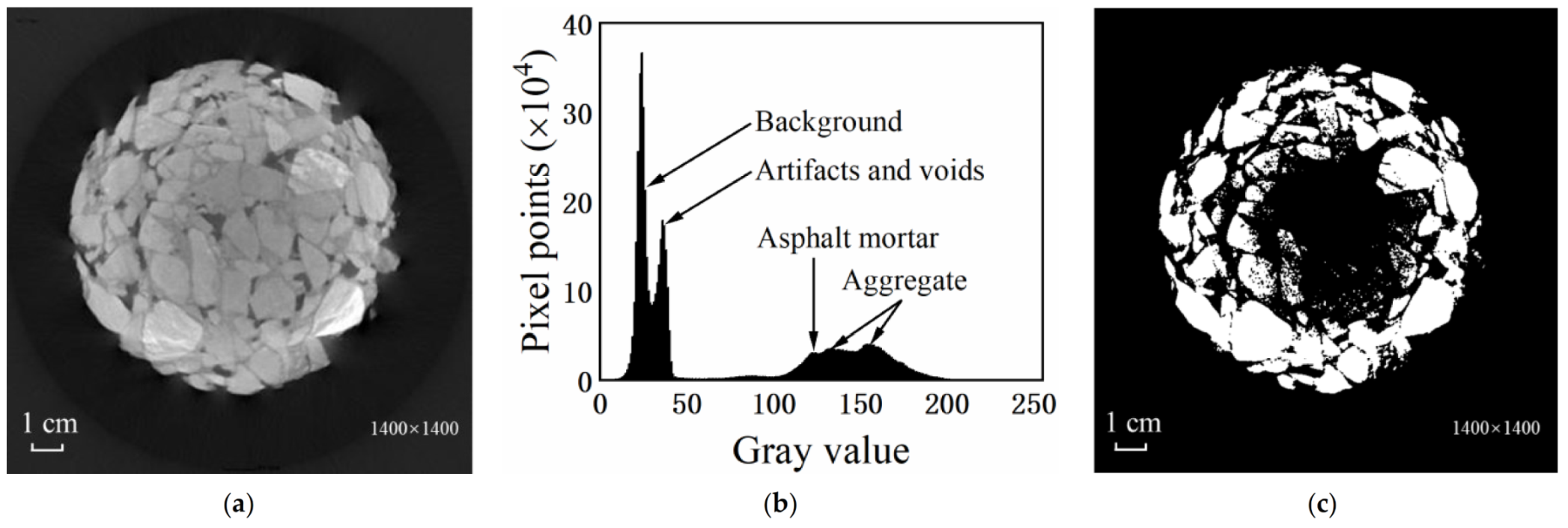
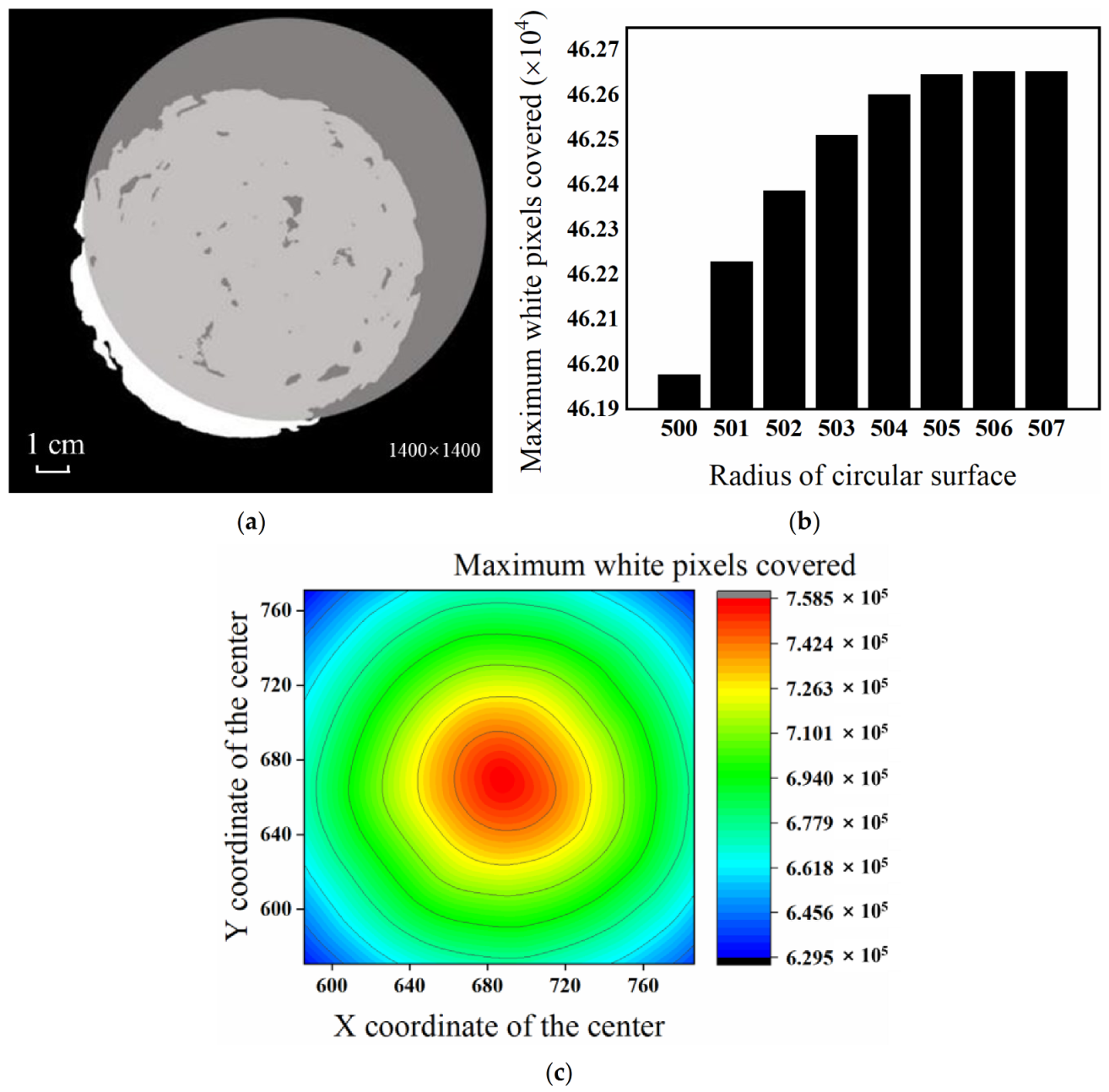
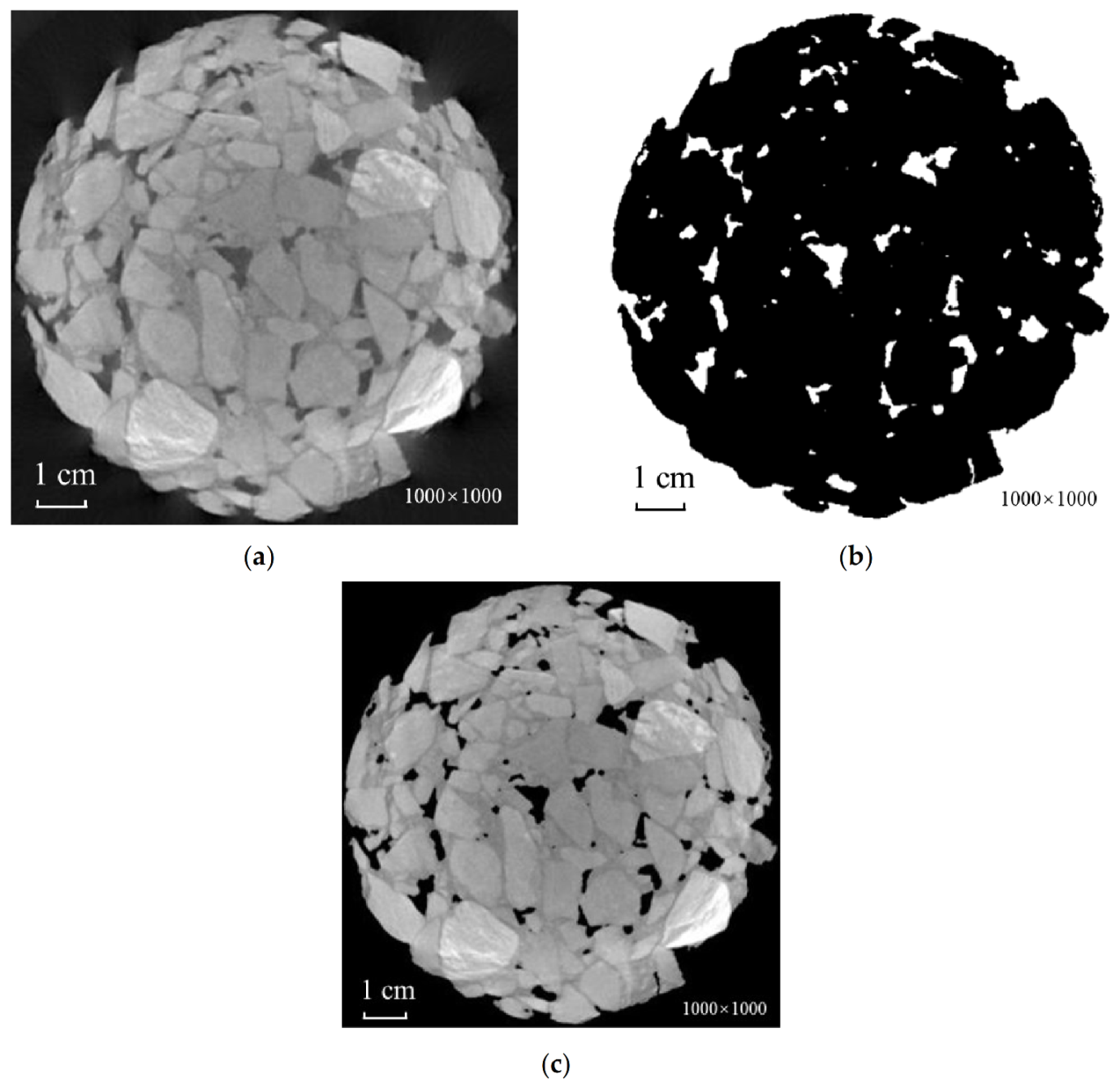
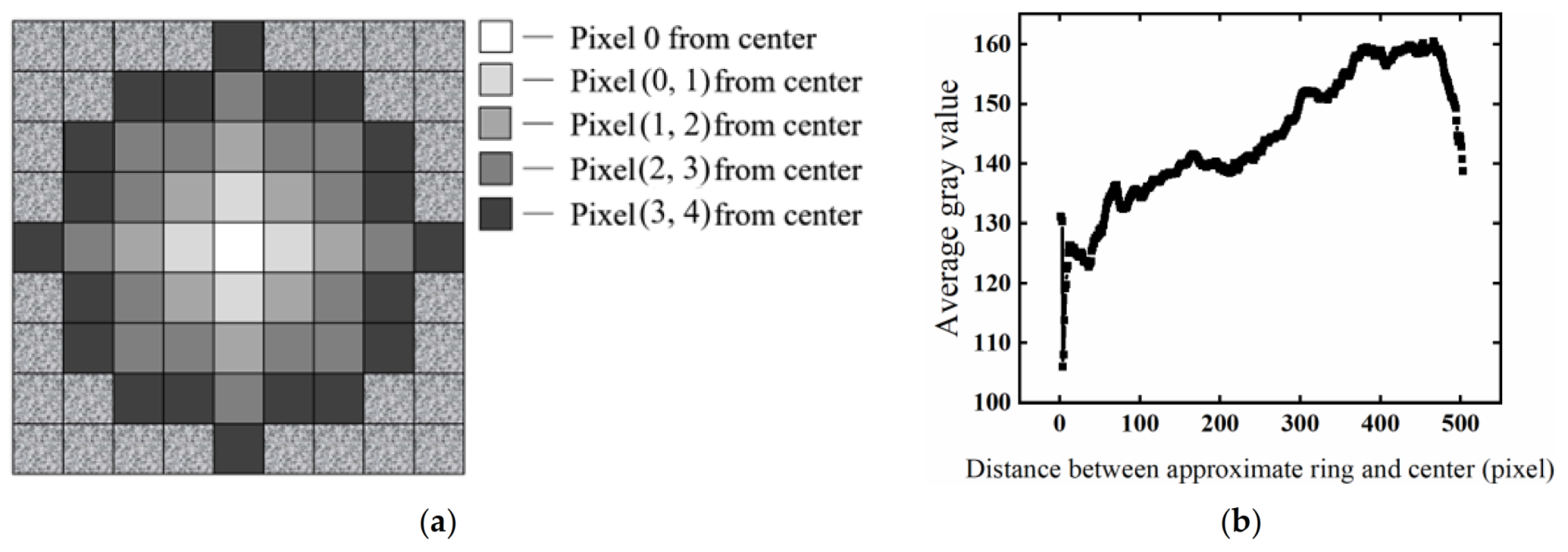
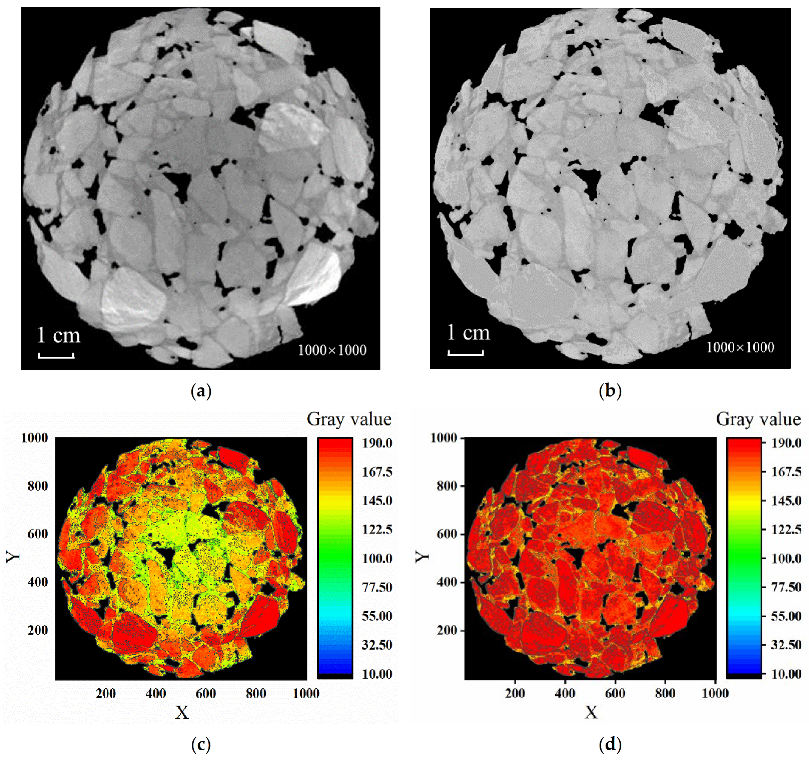



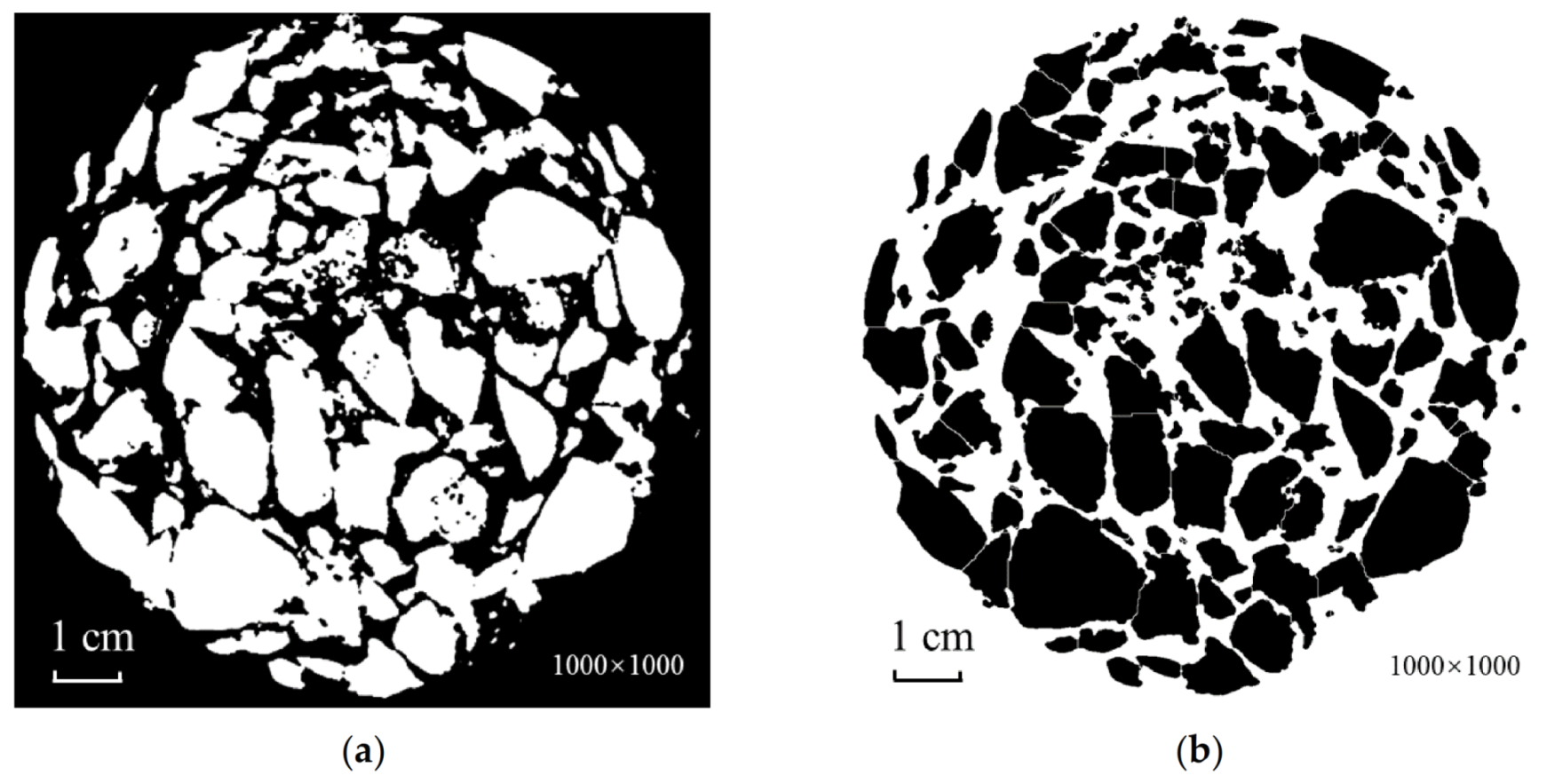


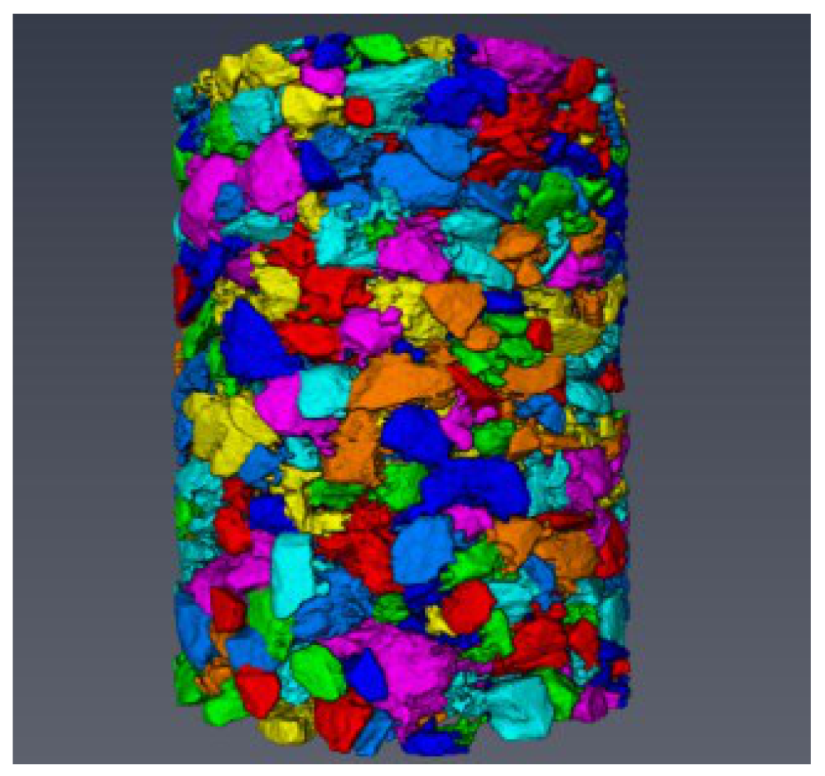
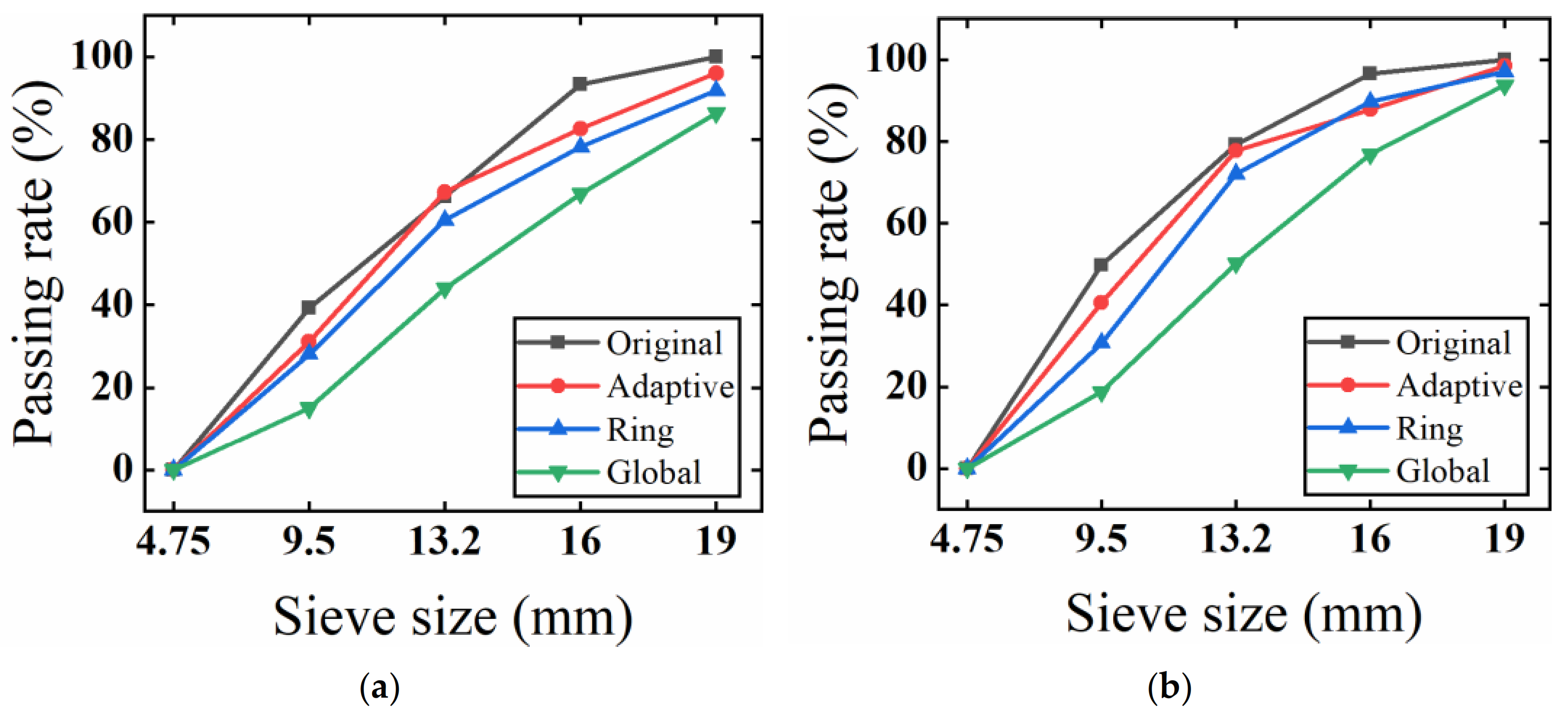
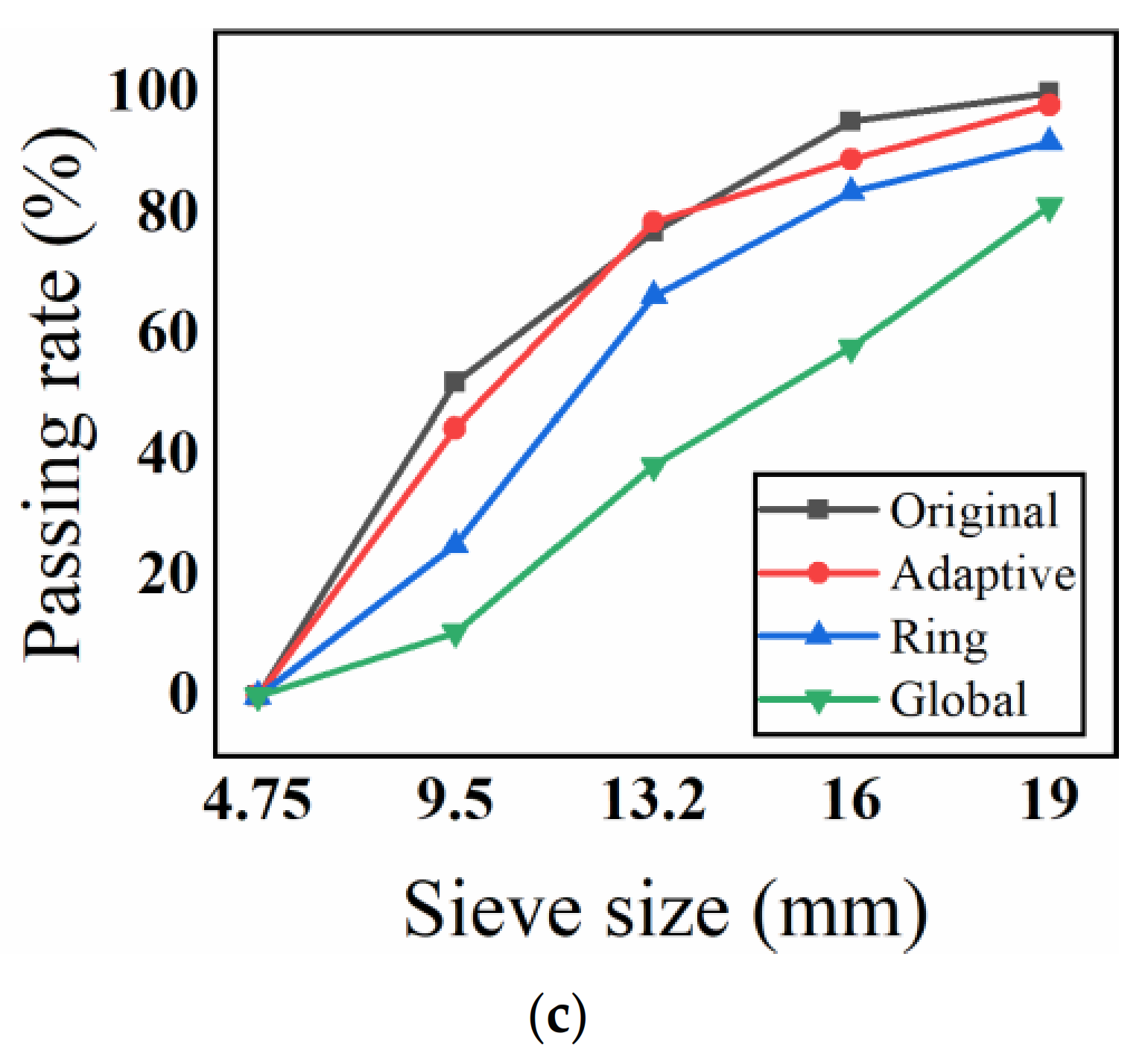
| Properties | Unit | Test Result | Specification Requirements | Specification |
|---|---|---|---|---|
| Penetration (25 °C, 100 g, 5 s) | 0.1 mm | 66.9 | 60~80 | JTG F40 |
| Ductility (5 °C, 5 cm/min) | cm | 43.3 | ≥30 | |
| Softening point | °C | 66.5 | ≥55 |
| Mixtures | Air Voids Content (%) | VMA (%) | VFA (%) |
|---|---|---|---|
| AC-16 | 3.5 | 13.9 | 74.9 |
| SMA-16 | 3.6 | 17.0 | 78.9 |
| OGFC-16 | 19.7 | 28.2 | 30.2 |
| Maximum Tube Voltage/kV | Maximum Tube Power/kW | Detail Resolution/μm | Minimum Distance from Focus to Test Pieces/mm | Maximum Pixel Resolution (3D)/μm | Geometric Magnification (2D) | Geometric Magnification (3D) |
|---|---|---|---|---|---|---|
| 240 | 320 | 1 | 4.5 | ≤2 | 1.460–180 | 1.46–100 |
| Evaluation Parameter | SMA-16 | OGFC-16 | AC-16 | ||||||
|---|---|---|---|---|---|---|---|---|---|
| Adaptive | Ring | Global | Adaptive | Ring | Global | Adaptive | Ring | Global | |
| Absolute error | 4.757 | 8.019 | 17.275 | 4.151 | 7.178 | 17.195 | 3.497 | 11.477 | 27.296 |
Publisher’s Note: MDPI stays neutral with regard to jurisdictional claims in published maps and institutional affiliations. |
© 2022 by the authors. Licensee MDPI, Basel, Switzerland. This article is an open access article distributed under the terms and conditions of the Creative Commons Attribution (CC BY) license (https://creativecommons.org/licenses/by/4.0/).
Share and Cite
Zhang, L.; Zheng, G.; Zhang, K.; Wang, Y.; Chen, C.; Zhao, L.; Xu, J.; Liu, X.; Wang, L.; Tan, Y.; et al. Study on the Extraction of CT Images with Non-Uniform Illumination for the Microstructure of Asphalt Mixture. Materials 2022, 15, 7364. https://doi.org/10.3390/ma15207364
Zhang L, Zheng G, Zhang K, Wang Y, Chen C, Zhao L, Xu J, Liu X, Wang L, Tan Y, et al. Study on the Extraction of CT Images with Non-Uniform Illumination for the Microstructure of Asphalt Mixture. Materials. 2022; 15(20):7364. https://doi.org/10.3390/ma15207364
Chicago/Turabian StyleZhang, Lei, Guiping Zheng, Kai Zhang, Yongfeng Wang, Changming Chen, Liting Zhao, Jiquan Xu, Xinqing Liu, Liqing Wang, Yiqiu Tan, and et al. 2022. "Study on the Extraction of CT Images with Non-Uniform Illumination for the Microstructure of Asphalt Mixture" Materials 15, no. 20: 7364. https://doi.org/10.3390/ma15207364




